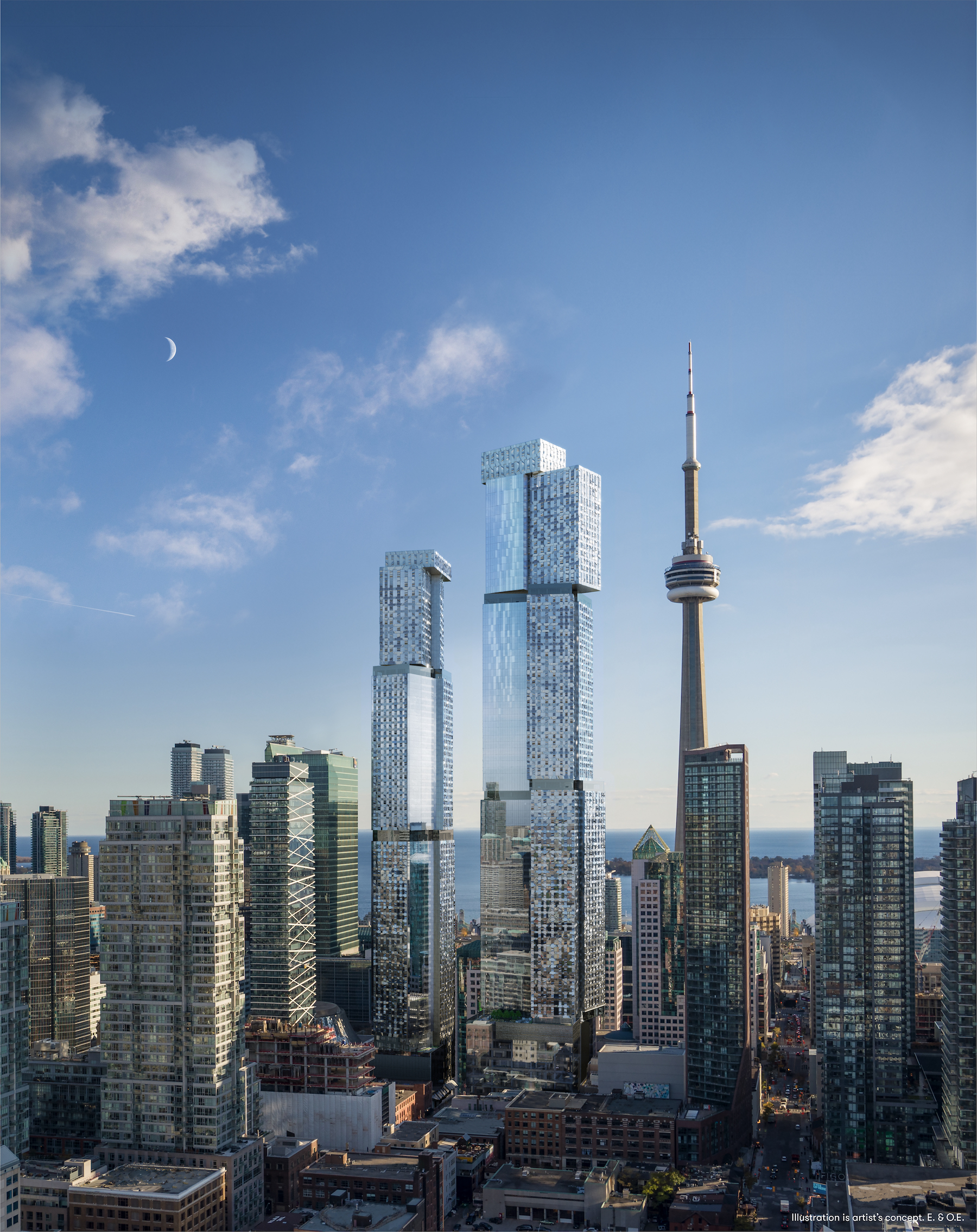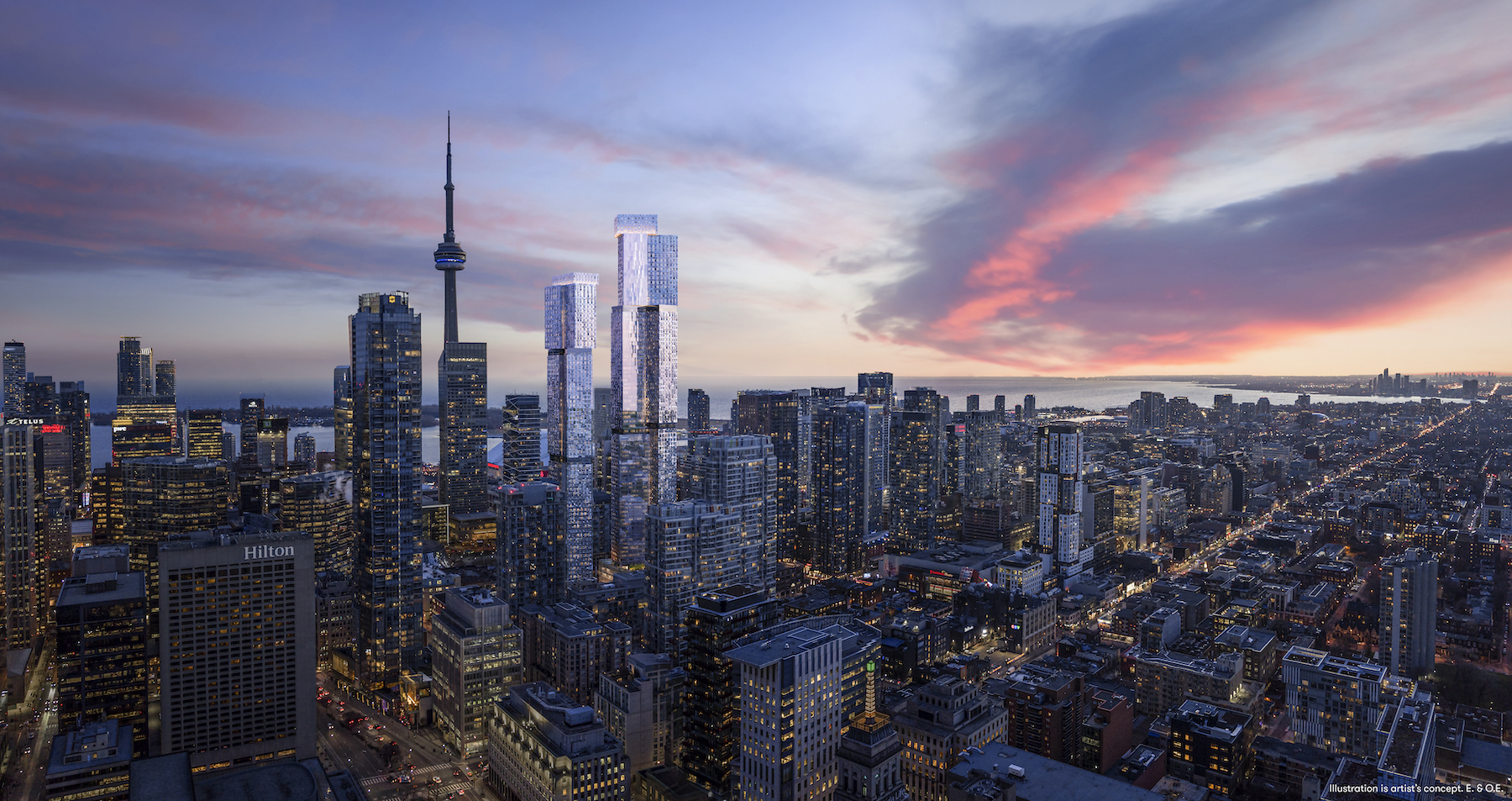Famed architect Frank Gehry will design his largest building to date for his hometown of Toronto, Canada. Developed by Great Gulf Group, Dream, and Westdale Properties, the mixed-use, two-tower development, called Forma, will mark the first Gehry-designed new development in Canada.
Considered one of the world’s most influential contemporary architects, Gehry has received numerous honors including the prestigious Pritzker Prize. His most notable projects include the Guggenheim Museum in Bilbao, the Walt Disney Concert Hall in Los Angeles, and Fondation Louis Vuitton in Paris.

Mixed-Use Building
Located in downtown Toronto, Forma will feature two residential towers: one at 73 floors and the other at 84 floors. It will house a total of 2,034 condominiums, in addition to commercial and retail spaces and a new space for OCAD University, an art and design school.
Forma takes its name from the Latin and Italian word for form, shape, and appearance. The twisting design of Forma’s towers will create a sense of movement, and its iridescent facade will reflect the changing natural light as well as Toronto’s surrounding skyline.
“Forma will be an exceptional addition to the city’s downtown Entertainment and Financial District,” Krystal Koo, head of marketing and sales, Dream Unlimited Corp, said in a statement.
“We are confident that Forma will put Toronto on the map as a world-class architectural destination,” added Mitchell Cohen, chief operating officer, Westdale Properties.
Established in 1975, the Great Gulf Group has delivered major projects in Canada and the US. Dream Unlimited is a Canadian real estate company founded in 1994. And for over 60 years, Westdale Properties has owned, managed, and developed real estate in Canada and the US.
Owner and developer: Great Gulf Group, Dream, and Westdale Properties
Design architect: Frank O. Gehry Architects
Architect of record: Adamson Associates Architects
MEP engineer: Smith + Andersen
Structural engineer: RJC
General contractor/construction manager: EllisDon
Related Stories
| Aug 11, 2010
Nurturing the Community
The best seat in the house at the new Seahawks Stadium in Seattle isn't on the 50-yard line. It's in the southeast corner, at the very top of the upper bowl. "From there you have a corner-to-corner view of the field and an inspiring grasp of the surrounding city," says Kelly Kerns, project leader with architect/engineer Ellerbe Becket, Kansas City, Mo.
| Aug 11, 2010
Two Rivers Marketing: Industrial connection
It was supposed to be the perfect new office. In July 2003, Two Rivers Marketing Group of Des Moines, Iowa, began working with Shiffler Associates Architects on a 14,000-sf building to house their rapidly growing marketing firm. Over the next six months they put together an innovative program that drew on unprecedented amounts of employee feedback.
| Aug 11, 2010
AIA Course: Historic Masonry — Restoration and Renovation
Historic restoration and preservation efforts are accelerating throughout the U.S., thanks in part to available tax credits, awards programs, and green building trends. While these projects entail many different building components and systems, façade restoration—as the public face of these older structures—is a key focus. Earn 1.0 AIA learning unit by taking this free course from Building Design+Construction.
| Aug 11, 2010
AIA Course: Enclosure strategies for better buildings
Sustainability and energy efficiency depend not only on the overall design but also on the building's enclosure system. Whether it's via better air-infiltration control, thermal insulation, and moisture control, or more advanced strategies such as active façades with automated shading and venting or novel enclosure types such as double walls, Building Teams are delivering more efficient, better performing, and healthier building enclosures.
| Aug 11, 2010
Glass Wall Systems Open Up Closed Spaces
Sectioning off large open spaces without making everything feel closed off was the challenge faced by two very different projects—one an upscale food market in Napa Valley, the other a corporate office in Southern California. Movable glass wall systems proved to be the solution in both projects.
| Aug 11, 2010
High School in a Hurry
One of the more compelling arguments for charter schools is their theoretical ability to streamline decision making. Eliminate all those layers of bureaucratic fat that clog the arteries of most public school systems, the argument goes, and decisions can be made to flow much more smoothly, even when it comes to designing and building a major school project.
| Aug 11, 2010
Right-Sizing Healthcare
Over the past 30 years or so, the healthcare industry has quietly super-sized its healthcare facilities. Since 1980, ORs have bulked up in size by 53%, acute-care patient rooms by 77%. The slow creep went unlabeled until recently, when consultant H. Scot Latimer applied the super-sizing moniker to hospitals, inpatient rooms, operating rooms, and other treatment and administrative spaces.
| Aug 11, 2010
Silver Award: Pere Marquette Depot Bay City, Mich.
For 38 years, the Pere Marquette Depot sat boarded up, broken down, and fire damaged. The Prairie-style building, with its distinctive orange iron-brick walls, was once the elegant Bay City, Mich., train station. The facility, which opened in 1904, served the Flint and Pere Marquette Railroad Company when the area was the epicenter of lumber processing for the shipbuilding and kit homebuilding ...
| Aug 11, 2010
Special Recognition: Durrant Group Headquarters, Dubuque, Iowa
Architecture firm Durrant Group used the redesign of its $3.7 million headquarters building as a way to showcase the firm's creativity, design talent, and technical expertise as well as to create a laboratory for experimentation and education. The Dubuque, Iowa, firm's stated desire was to set a high sustainability standard for both itself and its clients by recycling a 22,890-sf downtown buil...
| Aug 11, 2010
Hilton President Hotel
Once an elegant and fashionably trendy locale, the Presidential Hotel played host to the 1928 Republican National Convention where Herbert Hoover was nominated for President, and acted as a hot spot for Kansas City Jazz in the '30s and '40s. The hotel was eventually abandoned in 1984, at which point it became a haven for vagabonds and pigeons, collecting animal waste and incurring significant s...







